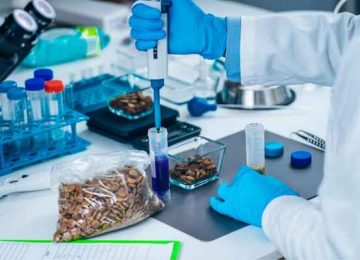

Guaranteeing Safe and Nutritious Food through Reliable Quality Control Testing
Get Your Food & Agri Products Quality Tested
Quality control testing of food is a crucial step in the food industry to ensure that the products being offered to consumers are safe, nutritious, and of high quality. The primary objective of quality control testing is to identify any potential contaminants, defects, or deviations in the food products and to take appropriate action to address these issues before they reach the consumers.
There are several types of quality control testing that are performed on food products, including:
- Microbial Testing: This type of testing is done to check the presence of harmful bacteria, yeasts, and molds in the food products. Samples are taken from the food and tested in a laboratory to determine if they contain any harmful microorganisms. If any harmful microorganisms are detected, the food is considered to be contaminated and is not allowed to be sold to consumers.
- Chemical Testing: This type of testing is done to check the presence of chemical contaminants such as pesticides, heavy metals, and other harmful substances. Chemical testing is also used to verify that the food products meet the required standards for nutrient content, such as protein, carbohydrates, and fats.
- Physical Testing: Physical testing involves checking the appearance, texture, and consistency of food products. This type of testing is used to identify any physical defects in the food products, such as broken or discolored pieces, and to ensure that the food products meet the desired quality standards.
- Sensory Testing: Sensory testing involves evaluating the taste, aroma, and appearance of food products. This type of testing is used to identify any sensory defects in the food products, such as off-flavors, unusual textures, or discoloration.
Quality control testing is performed at various stages of food production, including raw material sourcing, manufacturing, packaging, and storage. This helps to ensure that the food products meet the desired quality standards at every step of the process and that any potential issues are identified and addressed in a timely manner.
In conclusion, quality control testing is an essential aspect of the food industry that helps to ensure that the food products being offered to consumers are safe, nutritious, and of high quality. It is the responsibility of food companies to invest in quality control testing and to take the necessary steps to address any issues that are identified through the testing process.
Testing We Offer In Food & Agricultural Products
Chemical testing is another important aspect of quality control testing in the food industry. This type of testing is done to check the presence of chemical contaminants such as pesticides, heavy metals, and other harmful substances. Chemical testing is also used to verify that the food products meet the required standards for nutrient content, such as protein, carbohydrates, and fats.
- Pesticide Residue Testing: This type of testing is used to check the presence of pesticide residues in food products. Pesticides can be harmful to human health and therefore, it is important to detect and eliminate any residual pesticide levels in food.
- Heavy Metal Testing: Heavy metals, such as lead and mercury, can be present in food due to environmental pollution or contamination during processing. Heavy metal testing is used to detect and measure the levels of these contaminants in food products.
- Nutrient Analysis: Nutrient analysis is used to determine the levels of essential nutrients in food products, such as proteins, carbohydrates, fats, vitamins, and minerals. This type of testing is important to ensure that the food products meet the required standards for nutrient content.
- Mycotoxin Testing: Mycotoxins are toxic compounds produced by molds and can contaminate food products. Mycotoxin testing is used to detect the presence of these contaminants in food products and ensure that they are within safe levels for human consumption.
- Aflatoxin Testing: Aflatoxins are toxic compounds produced by certain molds and can contaminate food products such as peanuts, corn, and tree nuts. Aflatoxin testing is used to detect the presence of these contaminants in food products and ensure that they are within safe levels for human consumption.
- Melamine Testing: Melamine is a chemical used in the production of plastic products and can contaminate food products, particularly dairy products. Melamine testing is used to detect the presence of this contaminant in food products and ensure that it is within safe levels for human consumption.
- Food Additive Testing: Food additives are substances added to food to enhance their flavor, texture, appearance, or shelf-life. Food additive testing is used to detect the presence of these additives in food products and ensure that they are within safe levels for human consumption.
- Crop Contaminants Testing: Food safety is of utmost importance, and crop contaminant testing plays a crucial role in ensuring it. Crop contaminants are any substances that are not intentionally added to food, but may get into it during production, manufacture, processing, preparation, packaging, transportation or holding due to environmental contamination. This can include metal contaminants, toxic residues, insecticides, pesticides and more. The crop contaminant test helps identify potential threats in food commodities.
- Natural Toxin Testing: In food production, naturally occurring toxins can accumulate in food products. These toxins may include agaric acid, hydrocyanic acid, hypericin, and Safrole. The natural toxin test helps quantify these substances in food to ensure food safety.
- Sudan Dye Testing: Sudan dyes I, II, III, and IV are industrial dyes used in plastics and synthetic materials. However, they are not included in the positive list of authorized food colors, making their presence in food a violation of food safety regulations. Sudan dyes are carcinogenic and have a potential genotoxicity risk. The Sudan dye test helps detect food adulteration with these dyes and protects public health.
- Overall Migration Testing: Overall migration testing is conducted to monitor any change in the composition of food caused by contact with materials like aqueous or fatty stimulants. This test helps determine the overall migration limit (OML) and stability of food towards filling. Specific migration tests are also performed to check migration limits.
- Nicotine Testing: Nicotine is a highly addictive and toxic substance that can be found in cigarettes, vegetables, beverages, and more. To ensure food safety, nicotine tests are conducted to detect its presence in food products.
- Tobacco Nicotine Testing: Nicotine, the primary component of the Nicotiana Tabacum plant, is dangerous if ingested. Symptoms of nicotine poisoning can include vomiting, diarrhea, abdominal cramping, confusion, and convulsions. Mass spectroscopy methods are used to detect nicotine and its metabolite cotinine in tobacco samples.
- Steroid Identification Testing: Steroids are a group of compounds found in all animals and are used in medical treatments for various conditions. However, they can also have undesirable side effects. Steroid identification tests help determine the permissible levels of specific steroids in consumables.
There are several physical tests that can be performed on food to determine its quality and safety. Some of these tests include:
- Appearance: The visual examination of food includes its color, texture, and shape. This can help to identify any visual defects or changes in the food that might indicate spoilage or contamination.
- Texture: The texture of food can be measured using instruments such as a texture analyzer, which can determine the hardness, cohesiveness, and springiness of a food product.
- Density: Density is a measure of the mass of a food product per unit volume. It can be measured using instruments such as a density meter or by using a combination of weight and volume measurements.
- Moisture Content: Moisture content is an important parameter in the preservation and storage of food. It can be determined by using methods such as oven drying, microwave drying, or vacuum drying.
- pH: The pH of food is a measure of its acidity or basicity. A pH meter can be used to measure the pH of food, which can be an indicator of spoilage or the growth of harmful bacteria.
- Aw (Water Activity): Water activity is a measure of the availability of water in a food product and is a predictor of its shelf life. It can be measured using a water activity meter.
- Viscosity: Viscosity is a measure of the resistance of a food to flow. It can be measured using a viscometer, which can determine the viscosity of a food product under varying temperature and shear conditions.
Harmful microorganisms such as E. coli, Salmonella, Listeria, and Staphylococcus aureus can cause foodborne illnesses, which can range from mild digestive discomfort to severe and life-threatening diseases. Therefore, it is imperative to detect and eliminate any harmful microorganisms in food products before they reach the consumers.
There are several types of microbial testing used in food testing, including:
- Total Plate Count(TPC): Total plate count is a traditional culture-based method used to determine the overall level of bacteria present in a food sample. This method involves plating a sample of the food onto a growth medium, incubating the plates for a specified time, and counting the number of colonies that have formed.
- Pathogen Testing: Pathogen testing is used to detect the presence of specific harmful bacteria, such as Salmonella, Shigella, Clostridium, E. coli, and Listeria, S. aureus etc. in food products. Pathogen testing is important to ensure that food products are free from these microorganisms, which can cause foodborne illnesses.
- Yeast and Mold Count: Yeast and mold count is a traditional culture-based method used to determine the overall level of yeasts and molds present in a food sample. This method involves plating a sample of the food onto a growth medium, incubating the plates for a specified time, and counting the number of colonies that have formed.
- Aerobic Plate Count: Aerobic plate count is a traditional culture-based method used to determine the overall level of aerobic bacteria present in a food sample. This method involves plating a sample of the food onto a growth medium, incubating the plates under aerobic conditions for a specified time, and counting the number of colonies that have formed.
- Coliform Count: Coliform count is a traditional culture-based method used to determine the presence of coliform bacteria in food products. Coliform bacteria are commonly used as indicators of water and environmental contamination, and their presence in food products can indicate the presence of other harmful bacteria.


